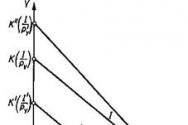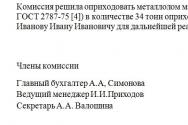Wallpaper flour: properties, features, application. Wholemeal flour: what it is and how it is used What is wholemeal and peeled flour
It is not easy so the main product in the diet of people is bread. Whatever it is made of, in whatever form it is used, it includes grains of various cereal crops. Cereals contain virtually all useful substances that ensure the healthy functioning of the body.
Previously, pastries from premium flour were introduced into the diet only on huge holidays. Such bread actually has no biological value - fine grinding leaves a lot of gluten, but impoverishes in suitable substances and fiber.
Those who adhere to the theses of a healthy diet, reducing the amount of food consumed, increase its biological value.
When you enter the diet of bread from bold flour, the work of the intestines is optimized, the general immunity of the body increases.
It is possible to bake suitable and appetizing bread independently, if you know what initial product is needed for this.
Information about flour familiar to everyone
Bread is baked from wheat, rye, wholemeal flour, oatmeal, pea, flaxseed or buckwheat are added for taste. To enhance the biological value of the final product or to add exotic, rice or even cassava flour substance is used for baking.
After a single grinding, whole grain flour is obtained. All parts are preserved in it: the embryo, seed and fruit membranes, endosperm particles. Another name for the substance is feed or feed.
Grinding depends on the size of the grains. Wholemeal flour is the most daring grinding for baking bread; grain grains up to 600-700 microns are found in it. The grain is threshed whole, without pre-cleaning, after processing, sieving is done through a large sieve or not at all. This flour contains bold shells of grain in large numbers.
The product of bold grinding contains a suitable substance that ensures metabolic processes in the intestines - this is fiber. It is the core food of suitable microbacteria that provide the immune defense of the body.
The grade of flour increases during grinding. With the whole operation, the grains become finer, the sieve screens out shells and bold inclusions. In ancient Rus', whole grain wheat flour was obtained by grinding cereals first in a mortar and then with millstones. Now grinding is carried out with cast-iron rollers.
Fine grinding of flour deprives it of the most suitable components: vitamin E, the one contained in the germ, a huge number of proteins and amino acids - they are in the sifted aleurone layer. Endosperm - the starchy layer - contains living cells.
Whole grain flour differs from whole grain flour in the following ways:
- whole grain contains all parts of the grain and its design is heterogeneous - grains of different sizes;
- the germ and grain shells are partly removed from the wallpaper, the number of bran is reduced, it is more of a homogeneous structure.
Thanks to a similar processing, the baking properties of whole wheat flour of bold grinding increase, and it is permissible to bake bread from it.
The variety of bread, the one that is allowed to be found on the shelves, is called "whole grain bread" or "bran". Both names are positive. In the flour of impudent grinding there are bran - albeit a small number, and slices of whole grains of cereals.
Types of flour and methods of use
On sale it is allowed to meet packages with whole grain flour:
- oat;
- barley;
- rye;
- wheat;
- buckwheat;
- pea.
When fresh, the flour has a nice smell, crumbly in texture, has a nice smell, slightly sweet.
The actual shelf life of the product is about 6 months.
Store packages often indicate a different storage time: from 12 to 18 months. Stabilizers, fillers, improvers and other preservatives were probably introduced into such a product.
Before baking bread from wholemeal flour, you need it:
- hold for at least 20 minutes outside the package so that it is ventilated and enriched with oxygen;
- add premium flour - in order to increase the number of gluten, on the contrary, the dough will not rise or fall off;
- make a mixture of various cereals - this will increase the biological value of the final product.
It is impossible to bake bread without additives. But you can get hefty appetizing cakes, waffles, pancakes. When eating these foods, energy will last for a long time - due to the table of contents of difficult carbohydrates, the nutritional value is high, the feeling of hunger will be blocked for a long time.
Rye is one of the most useful cereals.
Rye flour has an increased content of vitamins and minerals - 3 times more when compared with wheat:
- group B;
- vitamins E, F, P, PP;
- manganese;
- iron;
- calcium;
- copper and others.
Bread made from wholemeal rye flour is now in great demand among followers of a healthy diet. They are zealous to bake it independently in order to be completely confident in the quality and know the composition of the product.
When receiving flour, you need to pay attention to its color - it should be grayish-chestnut, but not too dark. It should not seem "heavy" if taken by the handful.
It is definitely not suitable for baking in its pure form. Gluten is completely absent in it, while there is a large number of alpha amylase, which converts starch into dextrin. Because of this, the bread does not rise.
If you are going to bake bread from such flour, then instead of yeast, you should use a special fermented milk sourdough. It contains bacteria much more than in yeast - 80 times - and it provides the right loosening. The fermentation process takes from 4 to 8 hours.
When baking at home, it is unthinkable to completely repeat the production process. So that the biological value of bread does not decrease, and at the same time its quality does not suffer, it is enough to add a little wheat flour of the highest grade to the peeled flour. Then it will be permissible to bake with traditional yeast.
If you introduce bread from bold flour into the diet every day, then the body's need for dietary fiber, vitamins and dietary fiber will be fully satisfied.
Rye flour obtained by coarse grinding of whole rye grains. As a result, the product has large particles, bran and cell membranes. Externally, the flour stands out for its dark gray color with a prominent brown tint. It is in this flour that the largest amount of bran particles is found.
Beneficial features
The benefit of rye wallpaper flour lies in its chemical composition. Compared to other varieties, it stands out for its potassium content, which lowers blood pressure, removes excess fluid and normalizes the activity of the cardiovascular system. There is also magnesium in such flour - an important mineral for the work of the heart muscle. Due to the presence of iron, the composition of the blood and the process of hematopoiesis improves.
The composition of wholemeal rye flour contains a large amount of fiber, which helps to cope with constipation and improve bowel activity and the digestive system as a whole. With the regular use of products made from rye wholemeal flour, metabolism, the work of the heart and blood vessels improves. In addition, the level of "bad" cholesterol decreases and the work of the gastrointestinal tract normalizes.
Contains rye flour vitamin E - a powerful antioxidant that is important for brain activity and rejuvenation of the body. It contains vitamin A and group B. It contains manganese, which is important for the proper development of cells. The mineral composition of wholemeal rye flour is large, for example, it contains phosphorus, sodium, molybdenum and many others.
Use in cooking
Whole rye flour is most often used for making table breads. It can be combined with wheat flour to get tasty and healthy pastries.
Harm of rye wallpaper flour and contraindications
Rye flour can cause harm when using products made from it in large quantities. This can negatively affect the work of digestion, metabolism and the figure.
According to GOST, there are several varieties of flour: higher, first, second, as well as peeled and wholemeal. The last two varieties, it would seem, are of the least quality and are in demand, however, this is not so. We want to tell you what wallpaper flour is and what is its value.
Whole grain flour
Characteristics and features

This product is called differently: wholemeal and whole grain flour, whole-ground, coarse grinding, simple grinding, etc. From these names, we can conclude that it is primarily in the various processing of wheat or rye grains. The way it is.
Cereal grain is a rather complex biological system, which consists of various parts arranged in the form of layers.
There are several main layers:
- Cereal germ and endosperm. Contains the largest amount of pure, easily digestible starch, used for the production of pasta, bread and pastries. Located in the middle of the grain;
- Bran. Separate the aleurone layer from the endosperm and contain many vitamins and trace elements;
- aleurone layer. Contains proteins and micronutrient-rich cells. It is located around the endosperm closer to the surface;
- Flower shell. This is, in fact, a husk rich in fiber and dietary fiber, which are good for the digestive system. This layer is located on the surface of the grain in the form of a shell.

Important! The product of the highest, first and second grades is made from the endosperm. What is the difference between wholemeal and peeled rye flour - peeled is called rye flour, peeled, and wallpaper - flour from unrefined grains.
Bread made from wholemeal flour is considered coarser and has a peculiar taste, its energy value is lower. However, the nutritional value is recognized by many experts as higher, since, in addition to starch, whole grain bread contains many trace elements, vitamins and fiber.

With the growing popularity of healthy eating, this product is becoming more and more in demand; many baked goods, pastries and other flour dishes are baked from it. However, we are interested in it for a different reason.
Whole-grain wholemeal flour is called wallpaper for a reason: for many years a paste was cooked from it - glue for paper, with which wallpaper was glued to the wall. This method is still relevant today, since the price of home-made glue is several times lower than store-bought glue, and the quality can be called satisfactory and even high.

Important! In addition to the undoubted nutritional value and richness in vitamins, fiber and trace elements, whole grain coarse flour also has technical value - it is used to prepare high-quality wallpaper glue.
And the most interesting thing is that the paste can be easily prepared at home completely on your own. Next, we will talk about the features of this product.
Application in construction

“The stores are full of wallpaper paste, why cook it yourself?” You ask, and you will be absolutely right. However, good glue is not cheap, and the flour version is in no way inferior, and in some respects even surpasses factory synthetics. Therefore, for those who want not only to save money, but also to use a completely natural and safe material, further reading will be useful.
First, we list the advantages and features of flour building materials:
- Low cost. For cooking, it is enough to have flour and water;
- Ease of manufacture. The product is boiled in ordinary water, after cooling it can be immediately used in work;
- Excellent adhesion to paper and many building materials. It is believed that such glue is able to stick even to old oil paint applied to the wall and at the same time hold the wallpaper coating on it for a long time and firmly;
- Solubility in water. Allows you to easily remove old wallpaper by wetting it with water. This method does not lead to damage to the walls and rough finish, the wallpaper can be easily removed and does not leave marks on the wall;
- Complete naturalness and safety for humans. As you understand, wheat and rye do not contain toxins or harmful substances, as well as their precursors. During operation, the material is absolutely safe;
- The product does not burn and does not enter into undesirable or dangerous reactions with other building materials.

Of course, there are some drawbacks to homemade paste. Firstly, it is afraid of moisture and is not suitable for installation in wet rooms and kitchens. Secondly, without the use of antiseptics and, especially, fungicides, the material can become an excellent breeding ground for bacteria and mold fungi.
You should also be careful when working with, as the product may leave marks on their surface if applied carelessly. It is believed that starch paste is not as dirty as flour paste.

The most significant drawback for mass production is the short shelf life. Wheat glue can turn sour and deteriorate already on the second day after production. In general, all of the above advantages apply in full only to a freshly brewed product.
But just remember that you can not use hot glue, as it can ruin the wallpaper and paint. Wait until it's barely warm.

Also, keep in mind that this is a paper adhesive, so you can only use it on paper or paper-backed materials. Actually, most wallpapers have just such a substrate.
Important! Boil the glue on the day you use it, as over time it loses its properties and deteriorates.
Paste preparation

If you are interested and decide with your own hands, then our instructions will be useful to you:
- We take a metal enameled bucket and pour into it from a third to a half of cold water. Pour 5 kg of flour sifted through a fine sieve into the water, while stirring constantly so that there are no lumps. Stir the mixture to a homogeneous creamy consistency;

- Then add boiling water to the same bucket in a thin stream to the top. At the same time, we also carefully stir the solution so that it does not take lumps and turns out to be homogeneous;

- We put the decoction with water on the fire and wait until it starts to boil. We put a rag or a layer of paper on the bottom, then put a bucket with the resulting solution there and bring to a boil. When the substance boils, we immediately remove it from the bath and filter it through a colander made of a fine metal mesh;

- After cooling, the product should be used immediately, it can not be stored for more than two days. Prepare as much as you can make in a day.

Important! The paste can be used as, but in this case it is better to apply it hot, having previously diluted it with boiling water twice.
Conclusion
Whole grain wheat flour is a very useful and sought-after product not only in the food industry, but also in the construction industry. Wallpaper glue is natural and durable, and everyone can cook it with the help of the video in this article.
The main requirement for a healthy diet is to reduce the amount of food consumed by increasing its biological value. In order for the main product in the human diet - - to comply with this principle, the flour from which it is baked must contain a maximum of useful substances with moderate.
Only in bread made from “coarse” flour is a storehouse of useful grain components preserved, namely, all, and, and, which fall victim to fine grinding and sifting during the production of raw materials for baking “elite” varieties.
Wholemeal flour, which contains all the useful substances necessary for the healthy functioning of the body, includes wheat wallpaper.
Excursion into history
The diet of our ancestors consisted of 90% roughage. Bread was no exception, which was baked from "coarse" flour, which contains the whole range of useful components of wheat grain. Initially, it was obtained by grinding cereals in a mortar or grain grinder, and later with the help of millstones. Nowadays, the most common way to obtain raw materials for baking is grinding wheat grains on cast-iron rollers.
Varieties of wheat flour differ in the amount of grinding of cereal crops. The product is obtained by single, wallpaper and varietal (repeated or stepped) grinding of grain.
As a result of a single grinding without separating the grain shells and further sifting, whole grain flour is obtained, the yield of which is 100%. It is known as "forage" or "stern". In such a product, there are those obtained by grinding the shell, as well as the embryo, the aleurone layer and the parts of the endosperm of the grain adjacent to it. All these components saturate it with vitamins, minerals, trace elements and cellulose.
In the production of wholemeal wheat flour, a special technology of single-grade wholemeal grinding is used. With such grinding, grain shells are partially removed, and the product yield does not exceed 96%. In terms of useful components, flour is practically not inferior to whole grain flour. Half a century ago, most of the bread was baked from such raw materials in the territory, which is now commonly called post-Soviet.
With the improvement of grain processing technology, varietal grinding has become most widespread, in which the shell is removed from the grains, and only small fractions remain after sieving. The higher the grade of flour, the finer the grinding. The lack of nutrients and fiber in such a product is combined with an excess of gluten. Buns and confectionery are baked from it.
 In addition to making bread and bakery products, various types of flour are used in the production of sausages and sauces, as well as confectionery and sweets.
In addition to making bread and bakery products, various types of flour are used in the production of sausages and sauces, as well as confectionery and sweets.
general characteristics
Whole wheat flour is characterized by the largest grinding, its grain grains reach 600-700 microns. The grain is not subjected to pre-cleaning and is crushed as a whole, after which it is sometimes sifted through a very large sieve. As a result of such processing, a product is obtained containing a large number of coarse shells and retaining almost all the useful properties of the grain.
Fresh flour has a pleasant smell, and its taste is sweetish. Its color is usually grayish brown. By consistency, it should be crumbly and not “heavy” if you pick it up in a handful.
You can store the product for about six months. At the same time, factory packaging often indicates a much more impressive shelf life - from 1 to 1.5 years.
However, this does not mean that “long-lived” flour is better in quality. Rather, on the contrary - a long shelf life indicates the inclusion of stabilizers, fillers and preservatives in its composition.
Chemical composition and calorie content
Whole wheat flour is a rather high-calorie product. Its nutritional value is 312 kcal per 100 g. The composition of nutrients is as follows: 11.5 g of proteins, 2.2 g and 61.5 g.
At the same time, wallpaper stands out among other varieties of wheat flour due to its chemical composition, which includes a huge amount of vitamins, minerals and useful elements. These are , B, E, PP, as well as beta-carotene, etc.
Separately, it is worth mentioning dietary fiber, which helps to remove toxins from the body and improve digestion. It is noteworthy that all of the above elements in whole wheat flour are in the most natural form - one to which, over the long years of human evolution, his digestion has adapted.
So, in 100 g of wholemeal flour: vitamin PP - 5.5 mg; - 0.4 mg; beta-carotene - 0.01 mg; - 0.9 mg; - 40 mcg; - 4 mcg; choline - 80 mg; vitamin A - 2 mcg; vitamin E - 3.3 mcg
The product is rich in natural compounds. So, 100 g of the product contains the following amount of macronutrients: 39 mg, 310 mg of potassium, 94 mg of magnesium, 7 mg, 336 mg, as well as microelements such as iron (4.7 mg); (2 mg); (400 mg); (22 mcg); selenium (6 mcg); sulfur (98 mg) and others.
Beneficial features
 As noted above, wheat wholemeal flour has a wide range of useful properties due to its chemical composition.
As noted above, wheat wholemeal flour has a wide range of useful properties due to its chemical composition.
- First of all, this flour contains all the components that are the key to the benefits of wheat as such. It has long been known that almost all the vitamins and minerals of the main cereal crop are concentrated in the shell - the one that is removed during the manufacture of "elite" white flour. In this raw material, all useful components are preserved almost in full, which gives nutritionists reason to consider such flour much more useful than the usual "white".
- Fiber is the "trick" of this product. These are the very shells of wheat grains that are not digested in our body, but at the same time they have a lot of useful properties. So, for example, they effectively stimulate intestinal motility, preventing stagnation and the onset of decay and fermentation processes. Fiber also interferes with the absorption of "bad" and works like a sponge, binding and removing toxins and toxic substances from our body.
- Baking made from whole wheat flour is considered dietary. It is recommended for use by people suffering from diabetes, overweight, diseases of the endocrine system.
- Calcium, manganese, iron and, present in the composition of wheat wholemeal flour, have a healing effect on the human circulatory and cardiovascular system. In particular, they make the vessels more elastic, prevent the formation of atherosclerotic plaques on their walls.
- Helping to improve the functioning of the intestines, dishes from this raw material also have a beneficial effect on the condition of the skin. In particular, the work of the sebaceous glands is normalized, rashes and peeling go away.
- Baking from flour of this type is considered hypoallergenic, while doctors do not get tired of repeating that “elite” varieties can cause allergic reactions.
- This raw material for baking is characterized by a high content of selenium, which has anti-carcinogenic properties and is used as a prophylactic, which helps to avoid the degeneration of benign tumors into malignant ones.
Contraindications for use
At the same time, despite a wide range of useful properties, whole wheat flour also has a number of contraindications for use.
Due to the presence of rather large particles in its composition, baking from it can irritate the mucous membrane of the stomach and intestines. Therefore, people suffering from gastritis or cholecystitis should refrain from eating wholemeal bread.
In addition, due to the fact that wheat undergoes only minimal processing, heavy metals can get into baked goods along with the shells of grains if the wheat grew in ecologically questionable areas. Also, the specific microflora present on the shells of the grains can disrupt the balance of the human intestinal microflora.
Use in cooking
It should be noted that in the "pure" form, whole wheat flour is practically not used in cooking. The thing is that, due to the high fiber content in its composition, baking from such raw materials rises very slightly, and the products themselves seem to be underbaked and do not look very aesthetically pleasing. So, bread made from this raw material, despite its bright, piquant taste, pleasant aroma and rich shade of crumb, looks heavy and rough.
 Therefore, experienced chefs usually mix wholemeal flour with high-quality flour, which allows, on the one hand, to preserve the beneficial properties of grains, and on the other hand, gives bakery products a delicate texture. This mixture is used for baking bread and rolls.
Therefore, experienced chefs usually mix wholemeal flour with high-quality flour, which allows, on the one hand, to preserve the beneficial properties of grains, and on the other hand, gives bakery products a delicate texture. This mixture is used for baking bread and rolls.
Flatbreads, wafers and pancakes are prepared from wholemeal flour in a “pure” form, which are distinguished by increased energy value and excellent taste.
Cooking bread from whole wheat flour with. In order to bake two loaves of fragrant and healthy bread, you will need the following ingredients: 360 g of whole wheat flour, the same amount of premium wheat flour, 8 g of dry yeast, 250 ml warmed, 200 ml, two full tablespoons of honey, 70 g , teaspoon, for sprinkling.
Boil the milk and cool it to a temperature of 40 degrees. Pour the yeast into warm water and let it stand for a quarter of an hour.
Dilute honey and butter in warm milk. Pour salt into the yeast, stir. Sift the flour there and pour in the milk with honey and butter. Knead the dough. It should be pretty soft. Knead the dough as thoroughly as possible, you can use a mixer.
Put the finished dough in a bowl, cover with cling film and leave in a warm place for 40-60 minutes to rise. Please note that if the dough rises too quickly, it can be punched down.
Grease the molds with oil. Put the dough on the table, divide into two parts. Roll it into balls and let it lie down for about a quarter of an hour. Then form the loaves and put them into the molds. Let stand warm for 35-40 minutes, then brush melted butter on top and sprinkle with sesame seeds, then send to an oven preheated to 190 degrees for 45 minutes.
Friends, we bake bread and all other pastries only on whole wheat flour: wheat, rye, oat, chickpea, millet, buckwheat, etc.
What does it mean? This means that the flour was made entirely from the whole grain, retaining all its useful components.
The grain is covered with a brownish shell. Simply put, this is BRAN.
They contain protein substances, but most of all it is fiber, vitamins of groups B and E, calcium, phosphorus, iron, magnesium. Bran first of all "cleans" the walls of the intestines, collects all the "dirt" and helps to remove it from the body.
The aleurone layer contains a large amount of proteins, vitamins B1 and B2, and especially vitamin PP.
The endosperm does not form gluten. First of all, it is the fat layer. This is why flour ground from whole grains can become bitter after a while.
Whole grain flour, unlike white flour (the highest grade), is stored for only a few months, not years.
Previously, they did not store flour, but grain in the barrels!
The mealy core occupies the entire inner part of the grain. It consists of large volumetric cells filled with starch, protein particles, gluten particles, and they give the dough viscosity. It is from this part of the cream-colored grain that flour is now sold everywhere.
GEM- this is the most important part of the grain, the basis of life. Everything else is just a shell that feeds and saves it. The germ is first removed during the production of white flour. The embryo is a storehouse of vitamins, proteins and trace elements.
What kind of flour is now used everywhere?
White flour - the so-called "High Grade".
As you now understand, the name here, unfortunately, does not correspond to the content of the flour, because. such a torment is devoid of all life.
It is also called "refined flour". It is made from the very core of the grain - the endosperm, which contains only starch, and to improve its keeping quality on the counter, baking powder can be added to it, and to give it a snow-white color, it can be bleached with chlorine.
The nutritional value of such flour (number of kcal) is really very high. But from the point of view of the biological value of the product, this is a carbohydrate “dummy”. In such flour, nothing useful and necessary for the body remains. From the carbohydrates of this flour, our body cannot create new cells; for this, it needs the whole variety of macro- and microelements, which nature provides only in WHOLE grains.
In addition to premium flour, wheat flour is produced:
- 1st grade,
- 2nd grade,
- and wallpaper flour (this is whole grain fine grinding).
and two varieties of rye flour:
- wallpaper (whole grain)
- peeled (bran partially removed).
All these varieties differ from each other in the fineness of grinding and the ratio of the constituent parts of the grain. The more components of the grain are contained in the flour and the larger the particles, the lower the grade.
What does the use of refined flour lead to?
- first of all, to a deficiency of fiber, the most powerful antioxidant;
- "vitamin of youth" - vitamin E;
- vitamins of group B;
- and vital minerals, especially iron.
Iron and zinc deficiency leads to many severe irreversible diseases: anemia, infertility, deterioration of vision and memory, malignant tumors, etc.
We need fiber to cleanse the body of toxins and toxic decay products. Without the presence of coarse dietary fiber in the diet, all harmful products accumulate in the body, which is the cause of many severe chronic diseases.
whole grain - this is food for our little helpers - intestinal bacteria (intestinal microflora), on which our health and our immunity depend on 90%.

They keep us warm and protect us from disease. As soon as they get the food they need, they immediately get to work. Their direct duty is to maintain the vital functions of all our organs.
All these biologically active components, which is also important, are in whole grain flour in a natural, understandable and digestible natural form for our body.
WHOLE GRAIN FLOUR. Wallpaper flour. Wholemeal flour.
Whole grain flour (whole grain) is obtained by grinding the whole grain. Accordingly, absolutely all the components of the grain remain in the flour. This is the flower shell of the grain, and the aleurone layer, and the grain germ. Thus, the entire biological value of whole grains and all its healing qualities for the human body are preserved.
Whole grain flour is fine and coarse grinding.
Wholemeal flour is the coarsest grinding of flour. Accordingly, sifting of wholemeal flour is carried out through a large sieve.
Whole grain flour is finely ground, which means that the grain is ground into smaller particles. This process, for example, takes more time in production than with coarse grinding, but baking with such flour turns out to be more fluffy and light.
No less important is which mill grinds the grain.
The most natural version of the mill - MILL with STONE MILLS.
You can buy such a mill on our website http://zdravyi.ru/komo.php
Mills with stone millstones used to be in almost every village where crops were cultivated in one way or another.
The grain in this case is ground between two stone shafts, practically without heating.
Flour mills mainly screw mills that do not grind, but chop grain.
In this case, there is contact with the metal, flour oxidation and heating.
Flour ground in a screw mill and a mill with stone millstones will be very different from each other, and its baking properties will also vary.
Whole grain flour is now more commercially available.
But we prefer our flour. The difference between purchased flour and freshly ground flour in a mill with stone millstones is colossal. Baking and bread on their own flour - they are different! Much tastier, it's hard to compare! Easy to digest, long lasting feeling of satiety! In general, it is very difficult to express in words, try it! Pancakes, buns, pies, cookies, bread - wonderful!
P.S.
Be sure to eat, including adding to bread, such whole grains and seeds:
Amaranth, Rye, Spelled, Barley, Oats, Wheat, Green Buckwheat, Chia Seeds, Flax, Hemp, Milk Thistle, Yellow Mustard, Millet, Quinoa, Black, Brown, Red and Wild Rice, Sorghum, etc.
See you on the site...
P.S.
Leave your comments on this post using the comment form below. Your opinion is extremely important to us :)
Please tell your friends about the recording through the social media buttons.







